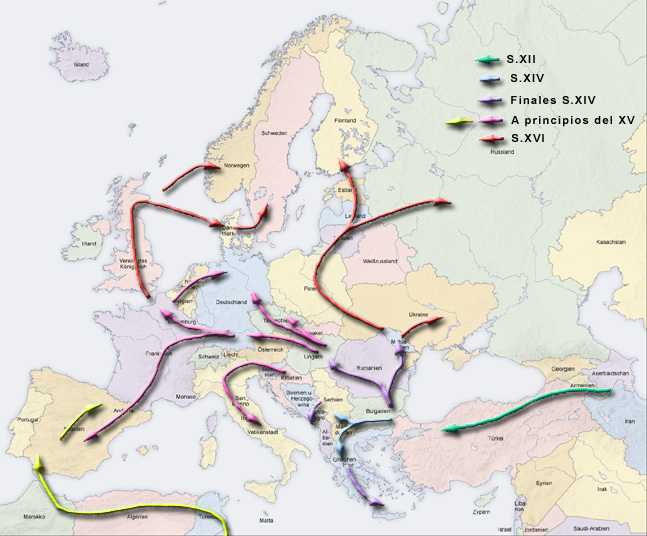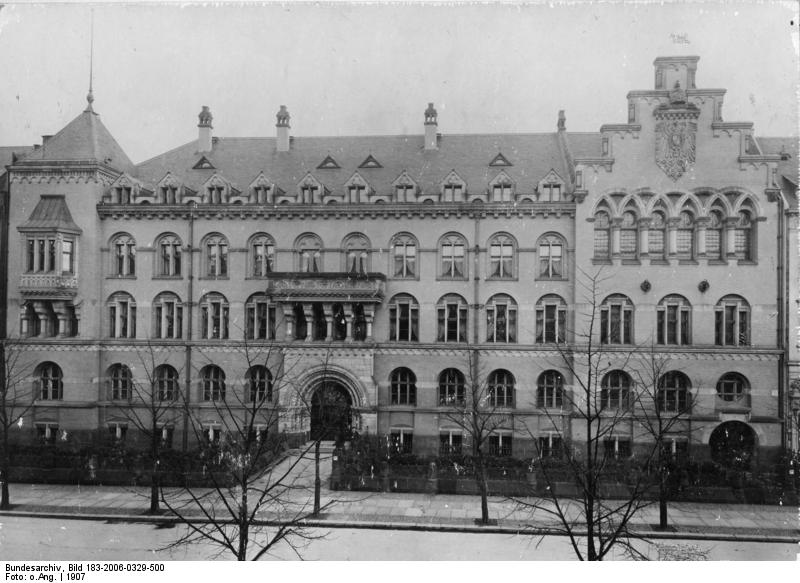シンティとロマ
The Sinti and the Romani

左がロベルト・リッターで中央はエヴァ・ユスティン(ハンブルグ 1938年)
シンティとロマ
The Sinti and the Romani

左がロベルト・リッターで中央はエヴァ・ユスティン(ハンブルグ 1938年)
シンティ(SintaまたはSinte、男性名詞:
Sinto、女性名詞:Sintesa)は、主にドイツと中央ヨーロッパに住む20万人ほどのロマニ(人)のサブグループである。彼らは伝統的に移動民で
あったが、現在では定住していないシンティはごく一部である。以前は、彼らはしばしばコミュニティの外れに住んでいた。中央ヨーロッパ(主にドイツ)のシ
ンティは、フランスのマヌーシュと呼ばれるグループと密接な関係にある。彼らはドイツ語の影響を強く受けたロマニ語のシンティ・マヌーシュ語を話す。
◎シンティとロマの区分について
| シンティ・ロマ(Sinti) |
The Sinti (also
Sinta or Sinte; masc. sing. Sinto; fem. sing. Sintesa) are a subgroup
of Romani people mostly found in Germany and Central Europe that number
around 200,000 people.[2][1][3] They were traditionally itinerant, but
today only a small percentage of Sinti remain unsettled. In earlier
times, they frequently lived on the outskirts of communities. The Sinti
of Central Europe (mostly Germany) are closely related to the group
known as Manouche in France.[4] They speak the Sinti-Manouche variety
of Romani, which exhibits strong German influence.[1][4] While people
from Sindh were mentioned in 1100 by the Arab chronicler Meidani, it is
unclear if Sindhi people are the ancestors of modern-day Sinti.[5]
Sinti are an ethno-linguistic group that is one of the oldest Indian
Subcontinent diasporas in Europe.The origin of the name is disputed.
Scholar Jan Kochanowski, and many Sinti themselves, believed it derives
from Sindhi, the name of a people of Sindh (a region now in southeast
Pakistan).[6] Scholar Yaron Matras argued that "Sinti" is a later term
in use by the Sinti from only the 18th century on, and is likely a
European loanword.[7][6] A recent study by Estonian and Indian
researchers found genetic similarities between European Romani men and
Indian men in their sample.[8] Linguist N.B.G. Kazi stated that all
Romani people are from Sindh.[9]
Some other possible locations, where the name Sinti derived from are
the Sindh River or the Sind River or Kali Sindh River.[citation needed]
Maybe also derived from Sind Valley or the Indus River in Sanskrit
named Sindhu, or the village Sinthee.[citation needed] Other Sinti
groups claim their ancestors are the Sindi people that came to Europe
earlier, and appear as Sintians in Sintice, now called Sintiki, where
their language Sintitikes derives from.[citation needed]The Sinti are a
subgroup of Romani people mostly found in Germany.[2] They arrived in
Austria and Germany in the Late Middle Ages as part of the Romani
emigration from the Indian Subcontinent,[10] eventually splitting into
two groups: Eftavagarja ("the Seven Caravans") and Estraxarja ("from
Austria").[11] They arrived in Germany before 1540.[12] The two groups
expanded, the Eftavagarja into France, Portugal and Brazil, where they
are called "Manouches", and the Estraxarja into Italy and Central
Europe, mainly what are now Croatia, Slovenia, Hungary,
Romania,[dubious – discuss] the Czech Republic and Slovakia, eventually
adopting various regional names.[13] In Italy they are present mainly
in Piedmont region (where in Piedmontese they are called Sinto,
although the word for Romani people is sìngher, as the Italian
zingari), with some communities in Veneto and Emilia Romagna as
well.[citation needed]The Sinti migrated to Germany in the early 15th
century. Despite their long presence, they were still generally
regarded as beggars and thieves, and, by 1899, the police kept a
central register on Sinti, Roma, and Yenish peoples. The Nazis
considered them racially inferior (see Nazism and race), and persecuted
them throughout Germany during the Nazi period – the Nuremberg Laws of
1935 often being interpreted to apply to them as well as the Jews.[14]
Adolf Eichmann recommended that Nazi Germany solve the "Gypsy Question"
simultaneously with the Jewish Question, resulting in the deportation
of the Sinti to clear room to build homes for ethnic Germans.[15] Some
were sent to Poland, or elsewhere (including some deported to
Yugoslavia by the Hamburg Police in 1939[16]) others were confined to
designated areas, and many were eventually murdered in gas
chambers.[17] Many Sinti and Roma were taken to Auschwitz-Birkenau,
where they were put in a special section, called the "gypsy camp". Dr.
Josef Mengele often performed some of his infamous experiments on Sinti
and Roma. On 2 August 1944 the "gypsy camp" was closed, and
approximately 4,000 Sinti and Roma were gassed during the night of 2–3
August and burnt in the crematoria. 2 August is now commemorated as
Roma and Sinti Holocaust Remembrance Day.[18]In the concentration
camps, the Sinti were forced to wear either a black triangle,
indicating their classification as "asocial",[19] or a brown triangle,
specifically reserved for Sinti, Roma, and Yenish peoples. |
シンティ(SintaまたはSinte、男性名詞:Sinto、女性名
詞:Sintesa)は、主にドイツと中央ヨーロッパに住む20万人ほどのロマニ(人)のサブグループである。彼らは伝統的に移動民であったが、現在では
定
住していないシンティはごく一部である。以前は、彼らはしばしばコミュニティの外れに住んでいた。中央ヨーロッパ(主にドイツ)のシンティは、フランスの
マヌーシュと呼ばれるグループと密接な関係にある。彼らはドイツ語の影響を強く受けたロマニ語のシンティ・マヌーシュ語を話す。アラブの年代記作家
Meidaniは1100年にシンド州の人々について言及しているが、シンド州の人々が現代のシンティ人の祖先であるかどうかは不明である。シンティは、
ヨーロッパにおける最古のインド亜大陸ディアスポラのひとつである民族言語集団である。名前の由来については議論がある。学者であるJan
Kochanowskiや多くのシンティ自身は、この名前はシンド(現在のパキスタン南東部の地域)の人々の名前であるシンディに由来すると考えている。
学者のヤロン・マトラスは、「シンティ」はシンティが18世紀以降に使用した用語で、ヨーロッパの借用語である可能性が高いと主張した。エストニア人とイ
ンド人の研究者による最近の研究では、ヨーロッパのロマニ男性とインド人男性のサンプルに遺伝的な類似性があることが判明している。言語学者の
N.B.G.
Kaziは、すべてのロマニはシンド州出身であると述べています。シンティという名前の由来は、シンド川、シンド川、カリ・シンド川などが考えられます。
また、サンスクリット語でSindhuと呼ばれるSind ValleyやIndus
River、またはSintheeという村に由来する可能性もある。他のシンティは、彼らの祖先は先にヨーロッパに渡ってきたシンディであると主張し、現
在シンティキと呼ばれるシンティケにシンティアとして現れ、彼らの言語シンティケスはそこから派生したものである。シンティは、主にドイツに分布するロマ
ニのサブグループである。彼らは中世後期、インド亜大陸からのロマ人移住者の一部としてオーストリアとドイツに到着し、最終的に2つのグループに分かれ
た。Eftavagarja(「7つのキャラバン」)とEstraxarja(「オーストリアから」)の2つのグループに分かれた。彼らは1540年以前
にドイツに到着した。エフタヴァルジャはフランス、ポルトガル、ブラジルに進出し「マヌーシュ」と呼ばれ、エストラクサルジャはイタリアと中央ヨーロッ
パ、主に現在のクロアチア、スロヴェニア、ハンガリー、ルーマニア、[dubious - discuss]
チェコ、スロヴァキアに広がり、最終的には様々な地域名を採用した。イタリアではピエモンテ州を中心に存在し(ピエモンテではシントと呼ばれるが、イタリ
ア語でロマの人々を指す言葉はシンガリである)、ヴェネト州やエミリア・ロマーニャ州にもいくつかのコミュニティが存在する。シンティ族は15世紀初頭に
ドイツに移住した。長い間存在していたにもかかわらず、彼らは一般に乞食や泥棒とみなされ、1899年には警察がシンティ、ロマ、イェニッシュの人々の中
央名簿を管理していた。ナチスは彼らを人種的に劣った存在とみなし(ナチズムと人種を参照)、ナチス時代にはドイツ全土で彼らを迫害した。1935年の
ニュルンベルク法はしばしば、ユダヤ人と同様に彼らに適用されると解釈された。アドルフ・アイヒマンはナチスドイツに「ジプシー問題」を「ユダヤ人問題」
と同時に解決するよう勧告し、その結果、ドイツ民族のための住宅建設の場所を確保するためにシンティを国外に追放することになった。ある者はポーランドや
その他の国に送られ(1939年にハンブルク警察によってユーゴスラビアに送られた者もいた)、ある者は指定された場所に閉じ込められ、最終的にガス室で
多くの者が殺害された。多くのシンティとロマがアウシュビッツ・ビルケナウに連行され、「ジプシー収容所」と呼ばれる特別な区画に入れられたのです。ヨー
ゼフ・メンゲレ博士はしばしばシンティとロマ人に対して悪名高い実験を行っていました。1944年8月2日、「ジプシー収容所」は閉鎖され、約4000人
のシンティとロマ人が8月2~3日の夜間にガス処刑され、火葬場で焼却されたのです。8月2日は現在、ロマ人とシンティ人のホロコースト記念日として記念
されています。強制収容所では、シンティ人は「非社会的」であることを示す黒い三角形か、シンティ、ロマ、イェニシュ人専用の茶色の三角形をつけることを
余儀なくされた |
| Romani, Romany, Roma. |
The
Romani (also spelled Romany /ˈroʊməni/, /ˈrɒ-/), colloquially known as
the Roma, are an Indo-Aryan ethnic group, traditionally nomadic
itinerants. Most of the Romani people live in Europe, and diaspora
populations also live in the Americas.
In the English language, the Romani people are widely known by the
exonym Gypsies (or Gipsies),[67] which is considered pejorative by many
Romani people due to its connotations of illegality and irregularity as
well as its historical use as a racial slur.[68][69][70] In many other
languages, regarding cognates of the word, such as French: Tzigane,
Spanish: gitano, Italian: zingaro, Portuguese: cigano, and Romanian:
țigan, this perception is either very small or non-existent.[71][72] At
the first World Romani Congress in 1971, its attendees unanimously
voted to reject the use of all exonyms for the Romani people, including
Gypsy, due to their aforementioned negative and stereotypical
connotations.[69]
Linguistic and genetic evidence suggests that the Roma originated in
the northern regions of the Indian subcontinent; in particular, the
Rajasthan, Haryana, and Punjab regions of modern-day India.[73][74][75]
They are dispersed, but their most concentrated populations are located
in Europe, especially Central, Eastern and Southern Europe (including
Southern France), as well as Western Asia (mainly Turkey). The Romani
people arrived in West Asia and Europe around the 14th century.[76]
Since the 19th century, some Romani people have also migrated to the
Americas. There are an estimated one million Roma in the United
States[6] and 800,000 in Brazil, most of whose ancestors emigrated in
the 19th century from Eastern Europe. Brazil also includes a notable
Romani community descended from people deported by the Portuguese
Empire during the Portuguese Inquisition.[77] In migrations since the
late 19th century, Romani people have also moved to other countries in
South America and to Canada. Though often confused with them, the
Romani people are culturally different from Irish Travellers and the
Yenish people, two groups who may be related to each other.[78][page
needed]
The Romani language is divided into several dialects, which together
are estimated to have more than two million speakers.[79] Many Romani
people are native speakers of the dominant language in their country of
residence or of mixed languages combining the dominant language with a
dialect of Romani; those varieties are sometimes called Para-Romani.[80] |
ロ
マ人は、インド・アーリア系の民族で、伝統的に遊牧民として知られている。ロマ人の多くはヨーロッパに住んでおり、アメリカ大陸にもディアスポラ集団が住
んでいる。英語では、ロマの人々はジプシー(またはジプシー)という呼称で広く知られているが、これは違法性や不規則性を意味し、また人種的中傷として歴
史的に使われてきたため、多くのロマの人々から侮蔑的なものとして扱われている。他の多くの言語では、フランス語のようなこの単語の同義語に関して。フラ
ンス語:Tzigane、スペイン語:gitano、イタリア語:zingaro、ポルトガル語:cigano、ルーマニア語:țiganなどの同義語に
ついては、この認識は非常に小さいか存在しない。1971年の第1回世界ロマン会議では、前述のネガティブでステレオタイプな意味合いから、ジプシーを含
むロマン派のすべての外来語の使用を拒否することが全会一致で決議されている。言語学的、遺伝学的な証拠から、ロマはインド亜大陸の北部、特に現在のイン
ドのラジャスタン、ハリヤナ、パンジャブ地方に起源を持つと考えられている。彼らは分散しているが、最も人口が集中しているのはヨーロッパ、特に中央、
東、南ヨーロッパ(南フランスを含む)、西アジア(主にトルコ)である。ロマニ族は14世紀ごろに西アジアとヨーロッパに到着した。19世紀以降、一部の
ロマの人々はアメリカ大陸にも移住している。米国には100万人、ブラジルには80万人のロマ人がいると推定され、彼らの祖先は19世紀に東ヨーロッパか
ら移住してきた人がほとんどである。ブラジルには、ポルトガルの異端審問の際にポルトガル帝国から追放された人々の子孫であるロマ人社会も存在する。ま
た、19世紀後半からの移住で、南米各国やカナダにもロマニ族が移動している。よく混同されりが、ロマーニはアイルランドのトラベラーやイエニッシュの人
々とは文化的に異なっており、互いに関係がある可能性もある。ロマーニ語はいくつかの方言に分かれており、合わせて200万人以上の話者がいると推定され
ている。多くのロマーニ人は、住んでいる国の支配的な言語を母語とするか、支配的な言語とロマーニ語の方言を組み合わせた混合言語を使用している。 |
 |
The migration of the Romanis through the Middle East and Northern Africa to Europe | |
| https://en.wikipedia.org/wiki/Sinti. https://en.wikipedia.org/wiki/Romani_people. |
ここではナチス政権期(1933年〜1945年のシ ンティ・ロマに対する人権侵害事案について検証する)
◎エヴァ・ユスティンとロマ民族.:エヴァ・ユスティン (Eva Justin, 1909年8月23日 - 1966年9月11日)は、ナチス時代に活躍したドイツの人類学者である。専門は科学的人種差別。彼女の研究は、シンティとロマの人々に対するナチスによ る犯罪行為に貢献した。1909年、鉄道職員の娘としてドレスデンに生まれ、ナチスの心理学者ロベルト・リッターの助手を務めた。看護婦としての訓練を受 け、1943年に大学の正規の手続きを踏まずにベルリン大学で人類学の博士号を取得した。オイゲン・フィッシャーが博士論文と最終試験を指導し、民族学者 のリチャード・サーンワルドが査読を行った[2]。ロマ語を話す彼女は、ロマやシンティの人々から信頼を得ていた。博士論文のタイトルは 「Lebensschicksale artfremd erzogener Zigeunerkinder und ihrer Nachkommen」(「ジプシーの子供とその子孫は、その種に不適切な方法で教育されたものである」)であった。ロマやシンティに対する、ハインリッ ヒ・ヒムラーに よる絶滅命令は1942年12月16日におこなわれた。Sophie Ehrhardtは、 the Race Hygiene and Population Biology Research Center in the Reich Health Office に勤務し、1938年から1942年まで勤務した。研究所は、1945年までに2万4千人に対して「完全なロマ」「雑種ロマ」「非ロマ」の分類業務をおこ ない、そのデータは収容所移送、殺害処分を含む断種などの決定に使われた。
◎ユスティンの上司であったロベルト・リッターとロマ民族:ロベルト・リッター(1901年5月14日 -
1951年4月15日)は、ドイツの人種科学者で、児童精神医学と犯罪の生物学を専門とする心理学と医学の博士であった。1936年、リッターはナチス・
ドイツの犯罪警察の人種衛生・人口生物学研究班の班長に任命され、ドイツの「ジプシー」であるロマ人とシンティ人(シンティ・ロマ)の系譜を確定し、「ロ
マ人とシンティ人が受ける実験の設計者」
となった。彼の疑似科学的な「研究」は、ドイツのこれらの人口を分類し、ナチス政府が「人種の純化」という目標に向かって組織的に迫害を行うことを積極的
におこなった。
◎シンティ・ロマへの補償がはじまるのは1970年代以降
「シンティ・ロマは15 世紀頃からドイツ語圏に定住したロマと同根のロマニ系の集団であるシンティ (Sinti)と、主に東欧に移住し、後のルーマニアに当たる地域で奴隷とされた集団であるロマとを併せた呼称。中世に後のオーストリア・ドイツ・北イタ リアに辿りついたと考えられ、シンティにはドイツ系住民と同化した者も多い。ナチス・ドイツの時代には、ナチズムのイデオロギーに基づくいわゆる「劣等人 種」だとしてシンティ・ロマも強制収容所に収容され、殺害された。犠牲者は30万人から50万人に上ると考えられているが、被害者・遺族への補償はロマに 対する人種的偏見やユダヤ人団体との対立から[1]進まず、補償が行われるようになったのはシンティ・ロマの運動や緑の党によるところが大きい[2]。 1971年に西ドイツシンティ中央委員会が結成され、翌年ドイツ・シンティ連盟に改名、1982年にはドイツ・シンティ・ロマ中央委員会(評議会)となっ た[2]。一方で、ロマニ系集団間のアイデンティティの違いも大きく、特にドイツではトランス・ナショナル志向の難民のロマとナショナル・マイノリティ志 向 のシンティの対立も報告されている[3]。」シンティ・ロマ)
◎ソフィー・エーデルハルトもまた戦争犯罪
を認定されることなく、戦後も犯罪学、犯罪遺伝学研究をチュービンゲン大学で継続しておこなうことができた。
◎Rassenhygienische und bevölkerungsbiologische Forschungsstelle 人種衛生人口生物学研究センター

ベルリンの帝国保健省の本館(1907年)は、ク
ロップストック通りのハンサヴィアーテルにあった。
+++
Links
リンク
文献
その他の情報


